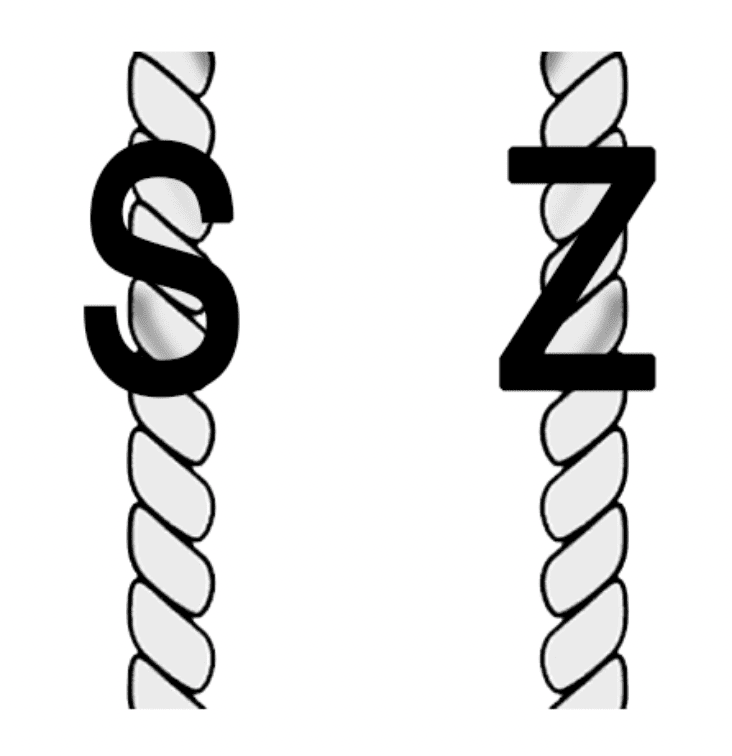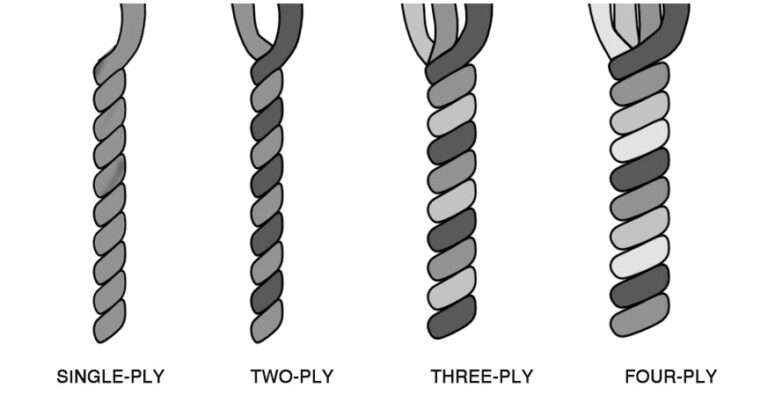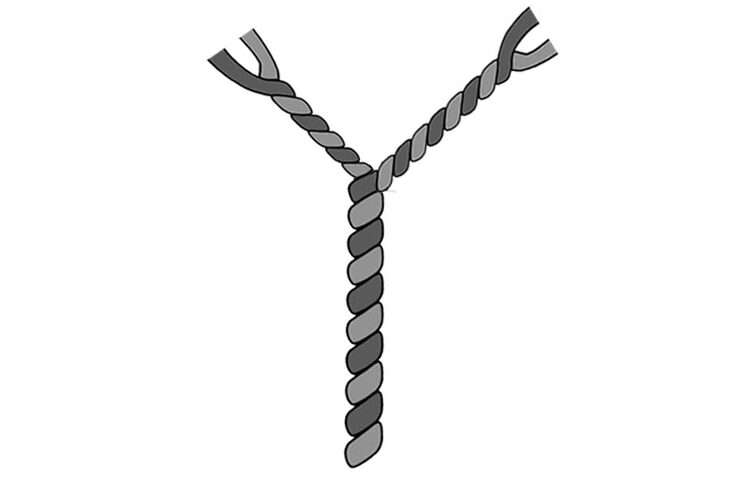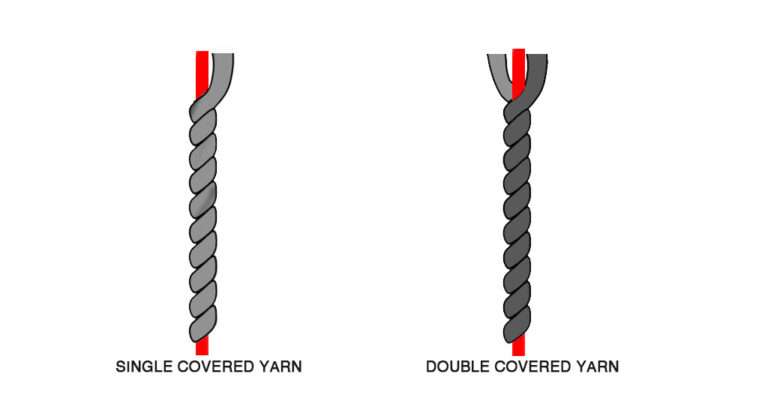Yarn is composed of twisted strands of fiber, which are known as plies when grouped together. These strands of yarn are twisted together (plied) in the opposite direction to make a thicker yarn. Depending on the direction of this final twist, the yarn will have either s-twist (the threads appear to go “up” to the left) or z-twist (to the right). For a single ply yarn, the direction of the final twist is the same as its original twist. The twist direction of yarn can affect the final properties of the fabric, and combined use of the two twist directions can nullify skewing in knitted fabric.The mechanical integrity of yarn is derived from frictional contacts between its composing fibers. The science behind this was first studied by Galileo Galilei.
As the name suggests, a single ply yarn is composed of just one strand of fiber. Manufacturers must carefully balance the amount of twist in the yarn, as too much twist can result in an “unbalanced” yarn that may cause biasing in knitted pieces, while too little twist can result in a weak, pill-prone yarn.Single ply yarns have a rounded cross-section that allows individual stitches to fill all the available space, resulting in a cohesive look and a cozy feel to the fabric. Stitches are smooth and bright, without the shadows that can appear in fabrics made with plied yarns. single ply yarns may not be well-suited for items that will receive a lot of wear and tear, such as socks or gloves, as they may not have the durability needed for these types of projects.
Two-ply yarns are composed of two strands of fiber that wind around each other, creating a definite wavy edge as the two strands interlock with each other. This structure provides increased strength and support for the fibers, making the yarn less prone to breaking. The excess twist from each individual ply is used to twist the two plies together, resulting in a more balanced yarn that is less likely to produce a biased fabric.The wavy edge of two-ply yarns can be advantageous in color-work projects, where the colors blend together more smoothly. Additionally, two-ply yarns are traditionally used for lace knitting, where the openwork pattern is accentuated by the yarn’s structure.
Three-ply yarns are more durable than single or two-ply yarns, with all of the twist in the individual plies plus the extra twist to ply them together. They are more round in cross-section than two-ply yarns, less round than single ply yarns, but stronger.
By adding more plies to a yarn, it becomes stronger, more durable, and more rounded, providing good structure for textured stitches and cables. Additionally, the more plies that are added, the denser the yarn becomes, as all available space within the column of yarn is utilized. This increased density can further enhance the strength and durability of the yarn, making it well-suited for projects that require resilience and sturdiness.
“Cord yarn” and “cabled yarn” are similar but not exactly the same.
Cord yarn is made by twisting two or more plies of yarn together in a specific way to produce a strong, round cord-like structure. This is typically done with a twisting machine that twists the plies together in a tight, uniform manner, resulting in a yarn that is dense and heavy.
On the other hand, cabled yarn is made by taking multiple plies of yarn and twisting them together in a specific way to produce a cable-like structure. This twisting is typically done by hand, creating a more relaxed and natural-looking yarn with a distinct, braided appearance.
So, while both cord yarn and cabled yarn involve twisting multiple plies of yarn together, the way in which they are twisted and the resulting appearance and properties of the yarns are different.
Yarns that are plied can be further plied together, which is a particularly advantageous construction for wool fibers such as Merino. Due to the relatively short, soft, and delicate nature of these fibers, the high total twist in the yarn helps protect them. This type of yarn is well-suited for textured stitch patterns like seed stitch (also known as moss stitch in the UK) and cables, as it provides strength and resistance to pilling. However, the multiple plies also keep the fibers tightly controlled, making this yarn less suitable for projects that require a more rustic appearance.
Covered yarns refer to a type of yarn in which one or more filaments or yarns are wrapped or covered with another strand of yarn or filament. The covering yarn or filament completely encases the core yarns, creating a smooth and continuous outer layer. The purpose of using covered yarns is to improve the performance and appearance of the fabric. The covered yarns can improve the yarn’s strength, elasticity, durability, and abrasion resistance. Additionally, covered yarns can be used to create various design effects and textures on the fabric’s surface. Covered yarns are widely used in the textile industry for manufacturing hosiery, knitwear, and various types of woven fabrics. The covering material can be made of various fibers, such as cotton, wool, silk, polyester, nylon, and spandex, depending on the desired properties and characteristics of the final product.
Single covered yarns consist of a core yarn that is wrapped with a second yarn.
A double covered yarn involves wrapping a core yarn with two distinct yarns. The purpose of the second layer of wrapping is primarily to balance out the twist direction of the first layer.
Core spun yarn is a type of yarn that is made by spinning fibers around a central core of a different fiber. The core is typically a strong and durable fiber, such as polyester or nylon, while the outer fibers can be a variety of materials, including cotton, wool, or acrylic. The outer fibers are spun around the core in a spiral pattern, which creates a yarn that is strong, stretchy, and resistant to pilling. Core spun yarn is commonly used in textile manufacturing for creating durable fabrics, such as denim, workwear, and outdoor apparel. It is also popular in the production of sewing threads because of its strength and resistance to breakage.
Ring Yarn and Open-End Yarn
Ring yarn and open-end yarn are two types of yarn produced by different spinning methods in the textile industry. Ring yarn is produced through a process called ring spinning. In this method, the fibers are first straightened and aligned by a carding machine, and then fed through a ring spinning frame. The frame uses a spindle to twist the fibers together to form a continuous yarn. The resulting yarn is strong, smooth, and consistent in thickness, making it suitable for high-quality fabrics. On the other hand, open-end yarn is produced using a technique called rotor spinning. In this method, the fibers are fed into a spinning rotor, which rotates at high speeds to twist and bind the fibers together to form yarn. Unlike ring yarn, the fibers in open-end yarn are not twisted continuously, but instead are twisted and cut at regular intervals by the rotor. This results in a yarn that is less smooth and uniform in thickness, but is more efficient and cost-effective to produce. In summary, ring yarn is a higher-quality, more refined type of yarn produced through ring spinning, while open-end yarn is a more cost-effective and efficient type of yarn produced through rotor spinning.
Ring yarn – carded refers to a type of yarn produced by spinning fibers that have been carded using a carding machine. Carding is the process of separating and aligning the fibers to create a continuous strand of fibers suitable for spinning into yarn. In the case of ring yarn – carded, the carded fibers are then spun into yarn using a ring spinning machine, which produces a smoother, finer, and more consistent yarn than other spinning methods. Ring yarn – carded is a popular choice for a variety of textile applications, including clothing, home textiles, and industrial textiles. It is known for its strength, durability, and smooth texture, making it suitable for use in garments and other products that require a high degree of quality and performance. Additionally, ring yarn – carded can be made from a variety of fibers, including cotton, wool, silk, and synthetic fibers, which allows for a wide range of applications and uses.
Ring yarn – combing is another type of yarn produced by spinning fibers that have been processed using a combing machine. Combing is a more advanced fiber preparation method than carding and involves further separating and aligning the fibers to remove shorter fibers and any remaining impurities. The resulting fibers are more uniform and have a longer staple length, which means they can be spun into a finer and stronger yarn. After the combing process, the fibers are spun into yarn using a ring spinning machine, which is the same as the process used for ring yarn – carded. However, since the fibers used in ring yarn – combing have been more thoroughly processed, the resulting yarn is finer and smoother, with fewer imperfections and inconsistencies. Ring yarn – combing is commonly used in high-end textile applications, such as luxury apparel, fine linens, and high-performance fabrics. It is known for its softness, strength, and luster, and is often made from premium fibers, such as long-staple cotton, merino wool, and silk. However, because of the additional processing required, ring yarn – combing is generally more expensive than ring yarn – carded.
Carded yarn is less expensive than combed yarn because it goes through a less intense processing method, which removes fewer parts from the cotton fibers. Combed yarn requires more labor to make and removes more impurities, resulting in finer and stronger yarn. However, the more impurities that are removed, the less yarn can be produced from the same amount of cotton. For example, if you start with 100 kg of cotton with debris, after removing the unnecessary items, you may end up with only 35 kg of raw cotton. Combing this raw cotton will produce even less yarn, about 20 kg, which makes high-quality combed yarn more expensive.
Open-end spinning system is a completely different production technique compared to ring yarn. Unlike ring yarn, it is produced from cotton’s short fibers. A rotor rotating at a very high speed is fed with the cotton roving prepared using short fibers. Thanks to the centrifugal force, the wick spreads and adheres to the rotor surface. Open-end yarn is produced by continuously pulling a yarn extended into the rotor. This yarn, which is produced by evaluating even the shortest fibers of cotton, is very economical. In order to ensure integrity, the number of twists must be higher than the ring system. This causes it to have a harder structure.
Ring yarn and open-end yarn are two different types of yarn manufacturing processes. The main difference between the two is the way the fibers are spun into yarn.
Ring yarn is made by twisting the fibers together using a spindle and a ring spinning machine. This process produces a stronger and smoother yarn with a finer, more uniform texture. Ring yarn is commonly used for high-quality garments, such as dress shirts, and for fabrics that require a high level of durability.
On the other hand, open-end yarn is made by spinning the fibers using a rotor spinning machine. This process is faster and less expensive than ring spinning, but it produces a yarn with a coarser texture and lower strength. Open-end yarn is often used for bulkier fabrics, such as towels, and for lower-end clothing items like t-shirts.
In summary, the main differences between ring yarn and open-end yarn are the spinning process, texture, strength, and end-use applications.







